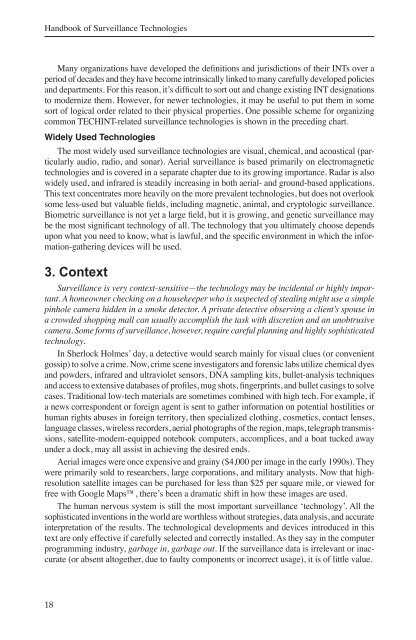Handbook of Surveillance Technologies (3rd Ed) - The Real Faces of ...
Handbook of Surveillance Technologies (3rd Ed) - The Real Faces of ...
Handbook of Surveillance Technologies (3rd Ed) - The Real Faces of ...
Create successful ePaper yourself
Turn your PDF publications into a flip-book with our unique Google optimized e-Paper software.
<strong>Handbook</strong> <strong>of</strong> <strong>Surveillance</strong> <strong>Technologies</strong><br />
Many organizations have developed the definitions and jurisdictions <strong>of</strong> their INTs over a<br />
period <strong>of</strong> decades and they have become intrinsically linked to many carefully developed policies<br />
and departments. For this reason, it’s difficult to sort out and change existing INT designations<br />
to modernize them. However, for newer technologies, it may be useful to put them in some<br />
sort <strong>of</strong> logical order related to their physical properties. One possible scheme for organizing<br />
common TECHINT-related surveillance technologies is shown in the preceding chart.<br />
Widely Used <strong>Technologies</strong><br />
<strong>The</strong> most widely used surveillance technologies are visual, chemical, and acoustical (particularly<br />
audio, radio, and sonar). Aerial surveillance is based primarily on electromagnetic<br />
technologies and is covered in a separate chapter due to its growing importance. Radar is also<br />
widely used, and infrared is steadily increasing in both aerial- and ground-based applications.<br />
This text concentrates more heavily on the more prevalent technologies, but does not overlook<br />
some less-used but valuable fields, including magnetic, animal, and cryptologic surveillance.<br />
Biometric surveillance is not yet a large field, but it is growing, and genetic surveillance may<br />
be the most significant technology <strong>of</strong> all. <strong>The</strong> technology that you ultimately choose depends<br />
upon what you need to know, what is lawful, and the specific environment in which the information-gathering<br />
devices will be used.<br />
3. Context<br />
<strong>Surveillance</strong> is very context-sensitive—the technology may be incidental or highly important.<br />
A homeowner checking on a housekeeper who is suspected <strong>of</strong> stealing might use a simple<br />
pinhole camera hidden in a smoke detector. A private detective observing a client’s spouse in<br />
a crowded shopping mall can usually accomplish the task with discretion and an unobtrusive<br />
camera. Some forms <strong>of</strong> surveillance, however, require careful planning and highly sophisticated<br />
technology.<br />
In Sherlock Holmes’ day, a detective would search mainly for visual clues (or convenient<br />
gossip) to solve a crime. Now, crime scene investigators and forensic labs utilize chemical dyes<br />
and powders, infrared and ultraviolet sensors, DNA sampling kits, bullet-analysis techniques<br />
and access to extensive databases <strong>of</strong> pr<strong>of</strong>iles, mug shots, fingerprints, and bullet casings to solve<br />
cases. Traditional low-tech materials are sometimes combined with high tech. For example, if<br />
a news correspondent or foreign agent is sent to gather information on potential hostilities or<br />
human rights abuses in foreign territory, then specialized clothing, cosmetics, contact lenses,<br />
language classes, wireless recorders, aerial photographs <strong>of</strong> the region, maps, telegraph transmissions,<br />
satellite-modem-equipped notebook computers, accomplices, and a boat tucked away<br />
under a dock, may all assist in achieving the desired ends.<br />
Aerial images were once expensive and grainy ($4,000 per image in the early 1990s). <strong>The</strong>y<br />
were primarily sold to researchers, large corporations, and military analysts. Now that highresolution<br />
satellite images can be purchased for less than $25 per square mile, or viewed for<br />
free with Google Maps, there’s been a dramatic shift in how these images are used.<br />
<strong>The</strong> human nervous system is still the most important surveillance ‘technology’. All the<br />
sophisticated inventions in the world are worthless without strategies, data analysis, and accurate<br />
interpretation <strong>of</strong> the results. <strong>The</strong> technological developments and devices introduced in this<br />
text are only effective if carefully selected and correctly installed. As they say in the computer<br />
programming industry, garbage in, garbage out. If the surveillance data is irrelevant or inaccurate<br />
(or absent altogether, due to faulty components or incorrect usage), it is <strong>of</strong> little value.<br />
18



